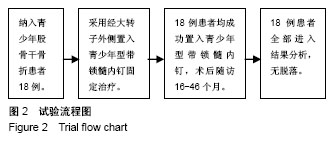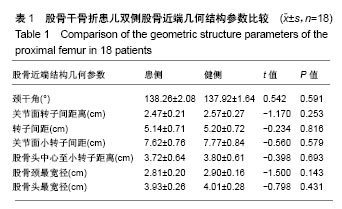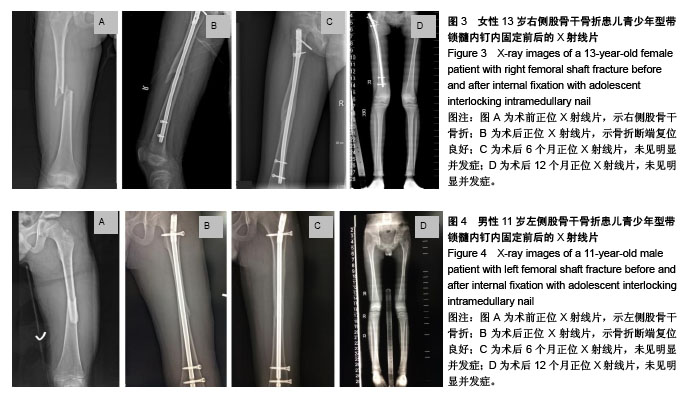| [1] Loder RT, O'Donnell PW, Feinberg JR. Epidemiology and mechanisms of femur fractures in children. J Pediatr Orthop.2006; 26(5):561-566.[2] Kocher MS, Sink EL, Blasier RD, et al. American Academy of Orthopaedic Surgeons clinical practice guideline on treatment of pediatric diaphyseal femur fracture. J Bone Joint Surg Am.2010; 92(8):1790-1792.[3] Jevsevar DS, Shea KG, Murray JN, et al. AAOS Clinical Practice Guideline on the Treatment of Pediatric Diaphyseal Femur Fractures. J Am Acad Orthop Surg.2015;23(12):e101.[4] Gordon JE, Mehlman CT. The Community Orthopaedic Surgeon Taking Trauma Call:Pediatric Femoral Shaft Fracture Pearls and Pitfalls. J Orthop Trauma.2017;31 Suppl 6:S16-S21.[5] Sutphen SA, Mendoza JD, Mundy AC, et al. Pediatric Diaphyseal Femur Fractures: Submuscular Plating Compared With Intramedullary Nailing. Orthopedics.2016;39(6):353-358.[6] Neumann MV, Südkamp NP, Strohm PC. Management of femoral shaft fractures. Acta Chir Orthop Traumatol Cech.2015;82(1): 22-32.[7] Roaten JD, Kelly DM, Yellin JL, et al. Pediatric femoral shaft fractures: a multicenter review of the AAOS Clinical Practice Guidelines Before and After 2009. J Pediatr Orthop.2017.[8] Gilbert SR, Maclennan PA, Backstrom I, et al. Altered lower extremity fracture characteristics in obese pediatric trauma patients. J Orthop Trauma.2015;29(1):e12-17.[9] Gilliland J, Clark AF, Kobrzynski M, et al. Convenience sampling of children presenting to hospital-based outpatient clinics to estimate childhood obesity levels in local surroundings. Am J Public Health.2015;105(7):1332-1335.[10] Beebe KS, Sabharwal S, Behrens F. Femoral shaft fractures: is rigid intramedullary nailing safe for adolescents?. Am J Orthop. 2006;35(4):172-174.[11] Paredes V, Franco A, Soto T, et al. A systematic review of rigid, locked, intramedullary nail insertion sites and avascular necrosis of the femoral head in the skeletally immature. J Pediatr Orthop. 2011;31(4):377-380.[12] Jr CS, Kim EJ, Koehler DM, et al. Twenty-year experience with rigid intramedullary nailing of femoral shaft fractures in skeletally immature patients. J Bone Joint Surg Am.2014;96(13):1080-1089.[13] Martus JE. Rigid intramedullary nailing of femoral shaft fractures for patients age 12 and younger: indications and technique. J Pediatr Orthop.2016;36:S35-40.[14] Gonzã P, Burgos-Flores J, Rapariz JM, et al. Intramedullary nailing of the femur in children. Effects on its proximal end. J Bone Joint Surg Br.1995;77(2):262-266.[15] Christensen CP, Althausen PL, Mittleman MA, et al. The nonarthritic hip score: reliable and validated. Clin Orthop Relat Res.2003;(406):75-83.[16] John R, Sharma S, Raj GN, et al. Current concepts in paediatric femoral shaft fractures. Open Orthop J.2017;11:353-368.[17] Rapp M, Kraus R, Illing P, et al. Treatment of femoral shaft fractures in children and adolescents ≥50 kg : A retrospective multicenter trial. Unfallchirurg. 2017.[18] Sutphen SA, Beebe AC, Klingele KE. Bridge plating length-unstable pediatric femoral shaft fractures. J Pediatr Orthop.2016;36 Suppl 1:S29-34.[19] Naranje SM, Stewart MG, Kelly DM, et al. Changes in the treatment of pediatric femoral fractures: 15-year trends from United States Kids' Inpatient Database (KID) 1997 to 2012. J Pediatr Orthop. 2016;36(7):e81-85.[20] Canavese F, Marengo L, Andreacchio A, et al. Complications of elastic stable intramedullary nailing of femoral shaft fractures in children weighing fifty kilograms (one hundred and ten pounds) and more. Int Orthop.2016;40(12):2627-2634.[21] Mooney JF. The use of 'damage control orthopedics' techniques in children with segmental open femur fractures. J Pediatr Orthop B.2012;21(5):400-403.[22] Guo YC, Feng GM, Xing GW, et al. A meta-analysis of flexible intramedullary nailing versus external fixation for pediatric femoral shaft fractures. J Pediatr Orthop B.2016;25(5):466-470.[23] Andreacchio A, Marengo L, Canavese F, et al. Comparison between external fixation and elastic stable intramedullary nailing for the treatment of femoral shaft fractures in children younger than 8 years of age. J Pediatr Orthop B.2016;25(5):471-477.[24] May C, Yen YM, Nasreddine AY, et al. Complications of plate fixation of femoral shaft fractures in children and adolescents. J Child Orthop.2013;7(3):235-243.[25] Heyworth BE, Hedequist DJ, Nasreddine AY, et al. Distal femoral valgus deformity following plate fixation of pediatric femoral shaft fractures. J Bone Joint Surg Am.2013;95(6):526-533.[26] 陈顺有,潘源城,林然,等. 肱骨交锁髓内钉治疗青少年股骨干骨折对股骨近端发育的影响[J]. 中国矫形外科杂志, 2016, 24(22): 2045-2048.[27] Mileski RA, Garvin KL, Crosby LA. Avascular necrosis of the femoral head in an adolescent following intramedullary nailing of the femur. A case report. J Bone Joint Surg Am.1994;76(11): 1706-1708.[28] Herndon WA. Premature greater trochanteric epiphysiodesis secondary to intramedullary femoral rodding. J Pediatr Orthop. 1994;14(1):130.[29] Trueta J, Harrison MH. The normal vascular anatomy of the femoral head in adult man. J Bone Joint Surg Br.1953;35-B(3): 442-461.[30] Siffert RS. Patterns of deformity of the developing hip. Clin Orthop Relat Res.1981;(160):14-29.[31] Weinstein SL, Mubarak SJ, Wenger DR. Developmental hip dysplasia and dislocation: Part I. Instr Course Lect.2004;53: 523-530.[32] Gordon JE, Swenning TA, Burd TA, et al. Proximal femoral radiographic changes after lateral transtrochanteric intramedullary nail placement in children. J Bone Joint Surg Am.2003;85-A(7): 1295-1301.[33] Keeler KA, Dart B, Luhmann SJ, et al. Antegrade Intramedullary Nailing of Pediatric Femoral Fractures Using an Interlocking Pediatric Femoral Nail and a Lateral Trochanteric Entry Point. J Pediatr Orthop.2009;29(4):345-351.[34] Hampton M, Maripuri N, Khandekar S,et al. Locked rigid antegrade intramedullary nailing of adolescent femoral fractures using a lateral trochanteric entry point. Acta Orthop Belg.2017; 82(4):829-853. |
.jpg)



.jpg)
.jpg)